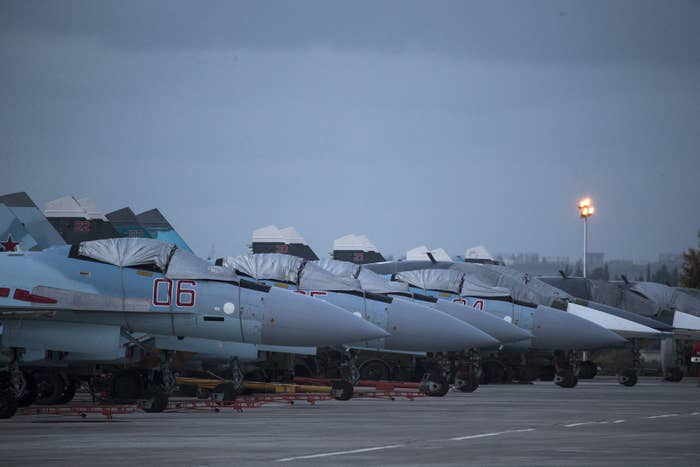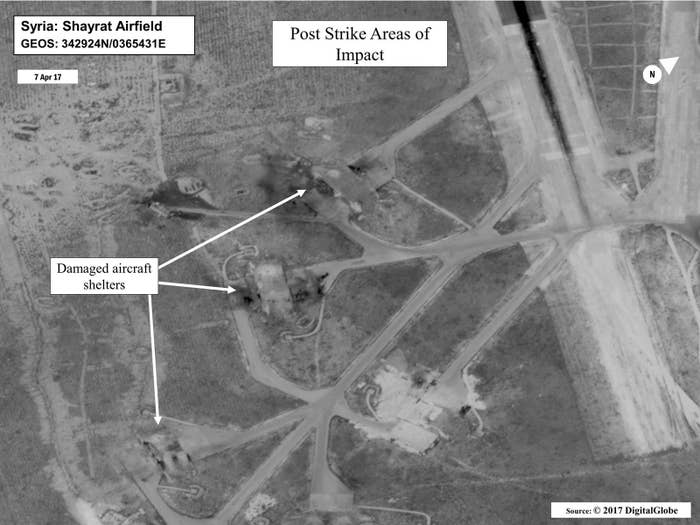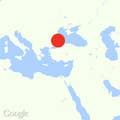
ISTANBUL — The Syrian air base that the Trump administration bombed on Thursday has been a key outpost for Russian troops and aircraft since the start of Moscow’s intervention in the country’s civil war, according to both US officials and military analysts who have studied satellite imagery of the facility taken over the past two years.
The Russian presence at the base highlights the risk of an unforeseen escalation in the already bafflingly complicated six-year-old civil war that has drawn the intervention of multiple world powers in a complex array of alliances involved in a fight for both control of the country and against ISIS.
Amid accusations from US officials, that in protecting the Syrian regime Moscow bears some responsibility for this week’s chemical-weapons attack by the Syrian military, which was launched from the same base, the Russian presence also underscores the extent to which the Syrian and Russian air campaigns often overlap in strategy, logistics and even in air traffic control efforts over an airspace that boasts air forces from more countries than any conflict since the Second World War over a relatively small swath of territory.
“Either Russia has been complicit or Russia has been simply incompetent in its ability to deliver,” Secretary of State Rex Tillerson told reporters on Thursday, referring to Moscow’s attempts to constrain Damascus.
The joint air base, called Al-Shayrat, sits in Syria’s central Homs province. It is used mainly by the Syrian military and hosts two squadrons of its Su-22 fighter jets, the same type of aircraft that launched the chemical attack, said Omar Lamrani, a senior military analyst at the research and intelligence firm Stratfor. But it also hosts Russian attack helicopters, he added, and has been one of Russia’s most important air bases outside its main installation in the port city of Tartous. While Syrian and Russian personnel work separately in conducting their missions, “it’s not like they’re completely separate,” Lamrani said. “They talk with each other; they probably play some soccer with each other. Obviously they coordinate to a certain extent.”
That assessments tracks with one provided by Pentagon briefers on Friday in the aftermath of the US strikes. The Russians kept aircraft, and as many as 100 personnel, including pilots and maintenance personnel at the base, the officials said. Russian and Syrian forces at the base are so intermingled that the Russians “knew every flight operation carried out of that airport,” one of the senior US military official who briefed reporters Friday explained.

Lamrani said that whether the Russians, knowingly or not, played any role in assisting with the Syrian chemical strike is “something that’s going to be a question mark in our minds.” On top of sending special forces, forward air controllers and technical specialists to join Syrian troops on the battlefield, Russia has played a key role in assisting Syria’s air war. “The Russians help with the overall situational awareness,” Lamrani said. “The biggest thing the Russians bring to the Syrians is intelligence, surveillance and reconnaissance. Directing them to where the enemy is located and just basically enhancing their planning.”
Russian involvement in this week’s chemical attack also remains unclear to the US military, briefers said, but the Pentagon will investigate any information that points toward Russian involvement.
Russia intervened in Syria in September 2015 to prop up the faltering regime of Syrian President Bashar al-Assad, moving military advisers, troops and aircraft into the country. From the start, recalled a former senior Obama administration official who was involved in Syria policy, “we saw a full integration of the two militaries from an air defense and aircraft sustainment approach. This is why we constantly stressed Russian culpability in Assad's actions.”
Yet the former official, who requested anonymity to discuss the sensitive subject, questioned whether the Trump administration had taken the time to weigh all the evidence. “At the same time, I remain concerned about the pace of all of this. Maybe this is a slam dunk case but it just feels all too fast and I'm worried they may have missed a step along the way,” he said. “I'd say that we were never presented with such an "open and shut" case like the one this administration is trying to present. It took painstaking review of all available Intel to draw conclusions about the battlefield. Each case is different.”
Al-Shayrat features two long intersecting runways, which were paved and extended by Russian engineers shortly after Moscow's intervention in Syria, flanked by dozens of hardened bunkers protecting Syrian warplanes. Satellite imagery analyzed by IHS Janes showed the facility in heavy use by at least a dozen Russian Mi-24 and Mi-35 attack helicopters in 2016, and multiple videos taken by Russian and Syrian soldiers and posted online show both kinds of Russian-marked helicopters operating from the base. According to the IHS Janes report, there had been no expansion of the base's housing facilities — and one online video apparently taken by Syrian soldiers shows them driving in close proximity to the Russian aircraft — indicating that both armies live in and operate in close quarters.

But while the close proximity of both countries militaries on a fairly small base would require close coordination in terms of managing Syrian ground attack jets and Russian helicopters flying in the same air space, it is unclear if the Syrian jets were directly receiving Russian logistical support.
“What we know is that this was a functioning Syrian base before the Russian intervention, so there is no reason why the Syrians would not be able to carry on functioning without Russian personnel assisting them on the ground," said Jeremy Binnie, the Middle East and Africa editor for IHS Jane’s Defence Weekly, who authored the initial report on Russia’s use of the facility. "That said, the [Syrian Air Force] has almost certainly benefitted from Russian support, including the provision of spare parts. … At the same time, Russian helicopters are known to have operated from the base in the past and may have been still there at the time of the TLAM strike, thus explaining the Pentagon’s reference to Russians being present. "
Binnie also said that any direct evidence of Russian involvement that might have been collected would be considered "military intelligence,” adding that there didn't appear to be any open source evidence that could confirm the link.
Russia said Friday that the US strikes did not kill any of the thousands of troops deployed across Syria, but the information sharing arrangement designed to avoid dangerous mishaps between Russian jets and those from the US-led coalition bombing ISIS mostly in the east may be a casualty. While Pentagon officials insisted the line remained open, and early indications from Moscow said the same, the Russian Ministry of Defense then said they’d informed the US that the hotline would shut down before the end of the day.
On the other hand, the US has ramped up rhetoric saying Russia bears responsibility for the chemical strike because of its broader support for Assad’s military campaign. The regime has continually used chemical weapons since it agreed to get rid of its stockpile in an agreement brokered by America and Russia in 2013. “The reality is that this is not the first time since 2013 that the Syrians have used chemical weapons,” Lamrani said. “They’ve deployed chlorine bombs, they’ve deployed sarin in at least two recent occasions. So in that sense the Russians know at a certain level that the Syrians have continued to use chemical weapons. So this specific [attack] aside, at a more strategic level, of course the Russians know the Syrian continue to use chemical weapons.”
Outside Your Bubble is a BuzzFeed News effort to bring you a diversity of thought and opinion from around the internet. If you don’t see your viewpoint represented, contact the curator at bubble@buzzfeed.com. Click here for more on Outside Your Bubble.
CORRECTION
Su-22 fighter planes fly from Al-Shayrat air base. A previous version of this article misidentified the type of plane.



